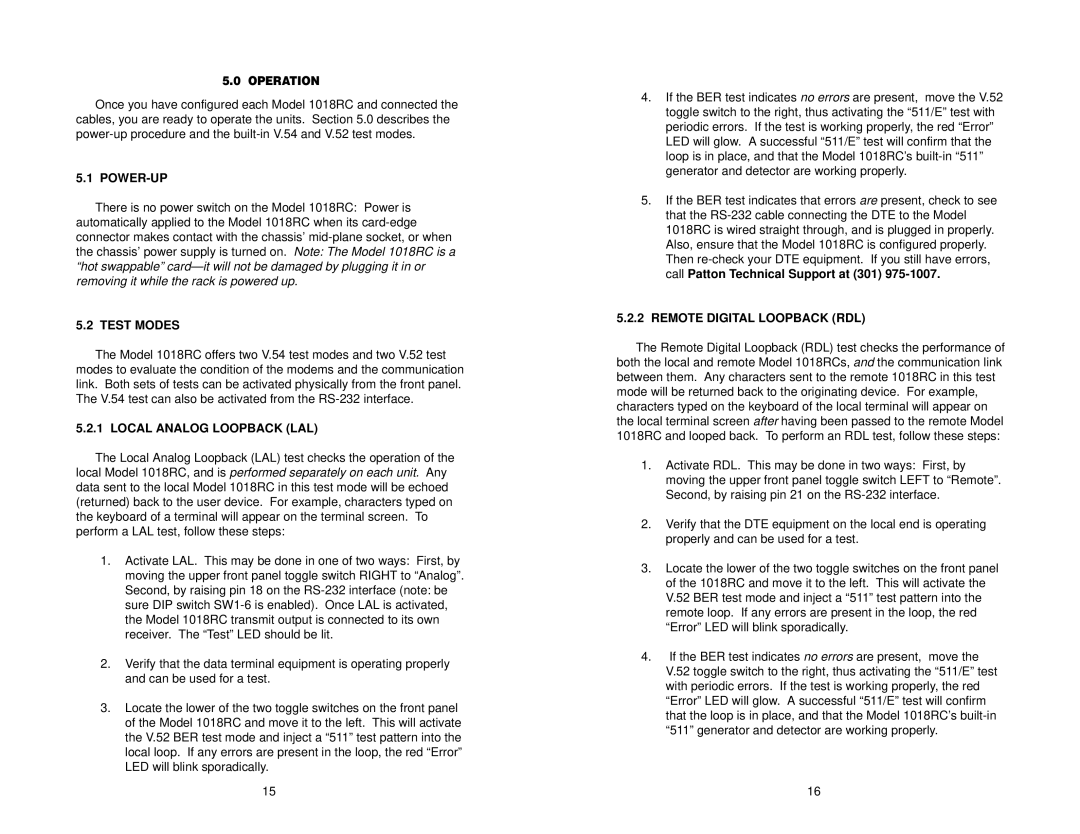5.0 OPERATION
Once you have configured each Model 1018RC and connected the cables, you are ready to operate the units. Section 5.0 describes the
5.1 POWER-UP
There is no power switch on the Model 1018RC: Power is automatically applied to the Model 1018RC when its
5.2 TEST MODES
The Model 1018RC offers two V.54 test modes and two V.52 test modes to evaluate the condition of the modems and the communication link. Both sets of tests can be activated physically from the front panel. The V.54 test can also be activated from the
5.2.1 LOCAL ANALOG LOOPBACK (LAL)
The Local Analog Loopback (LAL) test checks the operation of the local Model 1018RC, and is performed separately on each unit. Any data sent to the local Model 1018RC in this test mode will be echoed (returned) back to the user device. For example, characters typed on the keyboard of a terminal will appear on the terminal screen. To perform a LAL test, follow these steps:
1.Activate LAL. This may be done in one of two ways: First, by moving the upper front panel toggle switch RIGHT to “Analog”. Second, by raising pin 18 on the
2.Verify that the data terminal equipment is operating properly and can be used for a test.
3.Locate the lower of the two toggle switches on the front panel of the Model 1018RC and move it to the left. This will activate the V.52 BER test mode and inject a “511” test pattern into the local loop. If any errors are present in the loop, the red “Error” LED will blink sporadically.
15
4.If the BER test indicates no errors are present, move the V.52 toggle switch to the right, thus activating the “511/E” test with periodic errors. If the test is working properly, the red “Error” LED will glow. A successful “511/E” test will confirm that the loop is in place, and that the Model 1018RC’s
5.If the BER test indicates that errors are present, check to see that the
5.2.2REMOTE DIGITAL LOOPBACK (RDL)
The Remote Digital Loopback (RDL) test checks the performance of both the local and remote Model 1018RCs, and the communication link between them. Any characters sent to the remote 1018RC in this test mode will be returned back to the originating device. For example, characters typed on the keyboard of the local terminal will appear on the local terminal screen after having been passed to the remote Model 1018RC and looped back. To perform an RDL test, follow these steps:
1.Activate RDL. This may be done in two ways: First, by moving the upper front panel toggle switch LEFT to “Remote”. Second, by raising pin 21 on the
2.Verify that the DTE equipment on the local end is operating properly and can be used for a test.
3.Locate the lower of the two toggle switches on the front panel of the 1018RC and move it to the left. This will activate the V.52 BER test mode and inject a “511” test pattern into the remote loop. If any errors are present in the loop, the red “Error” LED will blink sporadically.
4.If the BER test indicates no errors are present, move the V.52 toggle switch to the right, thus activating the “511/E” test with periodic errors. If the test is working properly, the red “Error” LED will glow. A successful “511/E” test will confirm that the loop is in place, and that the Model 1018RC’s
16
